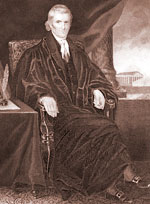
Students examine documents establishing the principal of judicial review in 1803.

During the early years of the American republic, the system of checks and balances between the three branches of the federal government was tested and solidified. This lesson examines the history behind the expansion of the Supreme Court's role and the principal of judicial review that came from the case of Marbury v. Madison in 1803. For teachers, one of the helpful things this website provides is secondary background reading and questions at three different ability levels. The easiest level provides help with vocabulary and may be suitable for English language learners. An engaging political cartoon analysis exercise is also included. The cartoon illustrates the balance of powers between the three branches of government, equating the Supreme Court to referees in a football game. In addition, excerpts of the most significant passages and other related texts are provided for students to read and interpret. We think teachers will appreciate the flexibility in the recommended sequence of activities. Activities can be tailored to how much time you have to teach about this important topic.
A variety of teaching materials about the U.S. judicial system and the Supreme Court are presented in the Landmark cases series co-produced by Street Law and the Supreme Court Historical Society.
Yes Materials used in the lesson have been well researched. Content and materials on the site are very thorough.
Yes Background information and questions are available for students at three different reading levels.
Yes Lesson focuses on reading and answering questions. No large, essay-style question for student writing is included, but students construct brief responses to questions about documents they have read.
Yes Students analyze documents to answer questions about who has the power to declare laws unconstitutional. The political cartoon analysis exercise centers on analytic thinking.
Yes Emphasis on reading primary sources. Source and perspective understanding are required when considering (for example) Thomas Jefferson's adverse reaction to the decision.
Yes This lesson is appropriate for a secondary audience, though this is not specifically stated on the site. Teachers may decide the activities and resources are appropriate for an eighth-grade class.
Yes In addition to the leveled background reading, an opening scenario, a diagram of the case, and excerpts from primary documents also work to support student understanding. Questions included with the sources require varied levels of understanding ranging from basic to quite sophisticated.
No Activities do not include assessment strategies other than questions that a teacher could assign to check for student understanding.
No No learning objectives are explicitly stated; however, the lesson activities progress logically.
Yes The lesson provides adequate instructions for implementation.